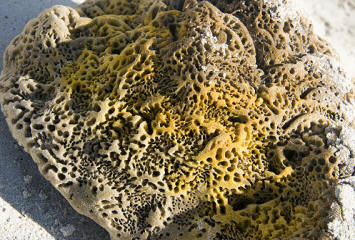Adaptation
Overview:
Sponges have a very unique adaptations stemming from their
cellular make-up. The phylum, Porifera, does not contain true
tissues and lacks complexity that other animal organisms
exhibit. However, they make up for this with their diverse
varieties of cells. Sponges contain four
 different
specialized cell types that have adapted to the sponges unique
way of life. First, there is the amoebcytes. These cells help
in both digesting material that the sponge obtains as well as
moving it around the organism. Spicules (made of either calcium
carbonate or silica) are ornate structures scattered around the
sponge mainly to aid in support and defense. The porocytes are
cell structures that allow water into the spongocoel (the atrium
of the sponge), and block larger, unnecessary molecules from
getting in. Finally, there are the choanocytes; they use their
flagella structures to create a current of water to the inside
of the sponge. These cells are thought to have originated from
the Protist group, Choanoflagellates.
different
specialized cell types that have adapted to the sponges unique
way of life. First, there is the amoebcytes. These cells help
in both digesting material that the sponge obtains as well as
moving it around the organism. Spicules (made of either calcium
carbonate or silica) are ornate structures scattered around the
sponge mainly to aid in support and defense. The porocytes are
cell structures that allow water into the spongocoel (the atrium
of the sponge), and block larger, unnecessary molecules from
getting in. Finally, there are the choanocytes; they use their
flagella structures to create a current of water to the inside
of the sponge. These cells are thought to have originated from
the Protist group, Choanoflagellates.
The Choanoflagellates special ability to form communal groups
that function as a single unit may very well be the explanation
of how animals developed from single-celled organisms... The
ultimate adaptation!
So how about Cryptotethya crypta?
Cryptotethya crypta, possibly one of the coolest sea
sponges ever, possesses two very interesting free-state elements
known as, 3-beta-D-arabofuranosylthymine
and 3-beta-D-arabofuranosyluracil. These are nucleic
acid-like compounds that act as cell replication inhibitors.
It is thought that when Cryptotethya crypta is
attacked by a predator, it releases these chemicals as some sort
of a defense mechanism. To learn more about the importance
of this peculiar adaptation please visit the
Medicinal Uses portion of my website!
Return Back to Top
Continue Onward to Nutrition...